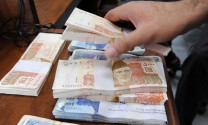Pakistan needs to look beyond exchange rate
Trade problems mainly caused by narrow manufacturing base, reliance on low-value processed products

PHOTO: REUTERS
The familiar argument, that of late has gained a lot of currency, is that the previous government by keeping the rupee higher viz-a-viz other currencies created distortions in the exchange rate regime, which made imports cheaper and exports expensive, contrary to the situation had market forces been allowed a free hand.
Not only did this translate into a massive trade deficit as imports scaled up and exports remained stagnant, it also stifled the domestic industry, which found it difficult to compete with cheaper imports.
The argument makes a lot of sense both theoretically and empirically. Theoretically, in an economy the self-correcting mechanism works like this: a considerable current account or trade deficit signifies that the demand for hard foreign currency (the dollar) far exceeds its supply. As a result, the dollar will appreciate and the domestic currency will depreciate. The fall in the relative value of the domestic currency will make exports cheaper and imports expensive, which will address the external deficits.
Empirically, in the face of an overvalued rupee, the trade and current account deficits went up from $22.16 billion and $3.12 billion respectively in FY15 to $23.9 billion and $5.45 billion respectively in FY16, to $32.48 billion and $13.13 billion respectively in FY17 and to $37.6 billion and $19.89 billion respectively in FY18.
Be that as it may, was an overvalued rupee the only, or even the capital, driver of massive external deficits? To answer this question, let’s look at the factors which govern an economy’s foreign trade performance.
Exports depend on several endogenous and exogenous factors. These include foreign market access including the size of key trading partners, their growth rates and trade barriers; the real exchange rate (nominal exchange rate plus relative price movements at home and abroad); and supply-side situation in the exporting country.
The latter includes factor endowment, manufacturing base, productivity of factors of production and other factors bearing upon cost, scale and quality of the output, such as the level of technology, production processes and the overall macroeconomic environment.
Import demand is the difference between domestic demand and domestic output (adjusted for exports). All else being equal, imports increase when domestic demand expands or when domestic output shrinks. Trade deficit occurs when economy is spending (imports) more than it is producing (exports of goods and services). Thus, a massive trade deficit is undergirded primarily by a low productive capacity.
Pakistan’s productivity constraints are well brought out by the composition of exports and their respective share in the world market. For juxtaposing the two variables, we will use calendar year data.
In 2017, the total size of the export basket was $21.87 billion. This included $3.95 billion for home textiles, $3.49 billion for cotton fabrics, $2.51 billion for knitted garments, $2.46 billion for woven garments, $1.75 billion for rice, $0.631 billion for leather articles, $0.511 billion for sugar, $0.410 billion for precision, medical and surgical equipment, $0.406 billion for fish, $0.385 billion for cement, $0.382 billion for beverages, $0.353 billion for fruits, $0.335 billion for raw hides and skins, $0.271 billion for plastics and $0.258 billion for petroleum products.
The cumulative size of these star 15 products came in at $18.13 billion, which accounted for nearly 83% of total exports. A look at the data will confirm that Pakistan’s export basket is laden with primary products, such as rice, fruits and fish; semi-processed products, such as sugar, cement and raw hides and skins; and low value-added goods such as textile and garments and articles of leather and plastic.
A sustained increase in exports is difficult to come by in the face of such a commodity-based export basket for the reason that not only do commodity prices fluctuate rapidly, there is also a long-term decline in non-oil commodity prices. Not surprisingly, non-oil commodity exporting countries perpetually run trade deficits.
Besides, as a rule, commodities lack product differentiation, upgrading and sophistication, which is necessary for a substantial and sustained increase in exports.
In these low value-added products, Pakistan’s share in the global market in most cases is exceedingly meagre. For instance, Pakistan accounts for 1.25% of world garment exports and 1.26% of world export of raw hides and skins, 1.58% of cereals, 0.85% of articles of leather, 0.07% of precision equipment, 0.28% of fruits and 0.04% of world exports of articles of plastics.
It is only in home textiles and fabrics that Pakistan has a considerable share of 7% each in the world market. By and large, Pakistan’s garments are sold to the low end of the market, which partly accounts for lower export revenue than if they were sold to the high-end fashion industry.
Import profile
Now we turn to Pakistan’s import profile. During the last financial year (2017-18), the import bill amounted to $60.86 billion, which included $14.43 billion for petroleum products, $11.57 billion for machinery and appliances, $8.91 billion for chemicals and pharmaceuticals, $5.35 billion for metals, $4.83 billion for vehicles and auto parts, and $1.29 billion for raw material.
The cumulative size of these products came in at $46.38 billion, which accounted for more than 76% of total imports. The import of these goods is essential to run offices and factories and to expand the economy.
Thus, for a substantial part of imports, Pakistan does not have strong import competing industries. Even in industries where we have sufficient productive capacity, the efficiency of production processes and the quality of products is not up to the mark.
For instance, the domestically grown cotton being of relatively poor quality is not used by the major export-oriented enterprises.
It follows that Pakistan’s foreign trade problems are productivity-based: a narrow manufacturing and export base, reliance on primary and low-value processed products and manufactures, lack of skilled labour and low marginal productivity of labour due to shortage of capital.
We also lack in product differentiation, which is vital to a substantial increase in exports. The exchange rate management did not cause these problems, so by itself it is not their cure.
Hence, despite steep depreciation of the rupee since December 2017, Pakistan’s exports registered only 0.1% increase on a year-on-year basis from $11.83 billion in July-December 2017 to $11.84 billion in July-December 2018 (SBP data). It follows that for scaling down the trade deficit, we need to look beyond exchange rate adjustments.
The writer is an Islamabad-based columnist
Published in The Express Tribune, February 4th, 2019.
Like Business on Facebook, follow @TribuneBiz on Twitter to stay informed and join in the conversation.



















COMMENTS
Comments are moderated and generally will be posted if they are on-topic and not abusive.
For more information, please see our Comments FAQ